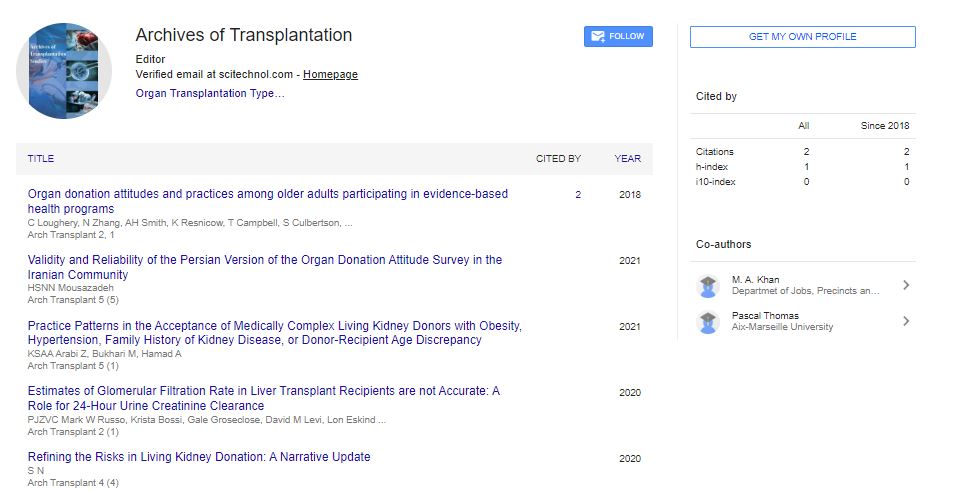Opinion Article, Arch Transplant Vol: 7 Issue: 2
Complexities of Graft Rejection during Transplantation
Andrea Frilling*
1Department of Surgery, Imperial College London, London, United Kingdom
*Corresponding Author: Andrea Frilling,
Department of Surgery, Imperial College
London, London, United Kingdom
E-mail: andrea@surg.uk
Received date: 24 May, 2023, Manuscript No. AT-23-107830;
Editor assigned date: 26 May, 2023, PreQC No. AT-23-107830 (PQ);
Reviewed date: 12 June, 2023, QC No. AT-23-107830;
Revised date: 19 June, 2023, Manuscript No. AT-23-107830 (R);
Published date: 26 June, 2023 DOI: 10.4172/AT.1000136
Citation: Frilling A (2023) Complexities of Graft Rejection during Transplantation. Arch Transplant 7:2.
Description
Transplantation is a life-saving procedure that replaces a failed organ with a healthy one. However, the success of transplantation is often challenged by the complex interplay between the immune system of the recipient and the transplanted organ. It depends up on the immunological mechanisms underlying graft rejection, the different types of rejection, and the challenges in achieving immune tolerance. By understanding these complexities, we can strive for improved strategies to prevent graft rejection and promote long-term graft survival.
Graft rejection occurs when the recipient's immune system recognizes the transplanted organ as foreign and launches an immune response to destroy it. The immunological basis of graft rejection involves both innate and adaptive immune responses. Innate immune cells, such as natural killer cells and macrophages, recognize foreign antigens on the transplanted organ and initiate an inflammatory response. This sets the stage for the subsequent adaptive immune response, which involves T cells and B cells. T cells play a central role in graft rejection. Donor antigens, known as Major Histocompatibility Complex (MHC) molecules, are recognized by T Cell Receptors (TCRs) on recipient T cells. This recognition triggers the activation of T cells, leading to the release of pro-inflammatory cytokines and the recruitment of other immune cells to the graft site. B cells also contribute to graft rejection by producing antibodies against donor antigens, leading to antibody-mediated rejection.
Graft rejection can manifest in different forms, classified as hyperacute, acute, or chronic rejection. Hyperacute rejection occurs within minutes to hours after transplantation and is primarily mediated by pre-existing antibodies in the recipient's blood. These antibodies bind to the donor antigens, activating complement proteins and causing rapid graft destruction. Acute rejection is the most common form of rejection, typically occurring within the first few months after transplantation. It involves T cell-mediated immune responses against the donor antigens. Acute rejection can present as cellular rejection, characterized by infiltration of immune cells into the graft, or as antibody-mediated rejection, involving the production of donorspecific antibodies. Chronic rejection, also known as graft vasculopathy, occurs over months or years after transplantation. It is a gradual process characterized by fibrosis and narrowing of the blood vessels in the transplanted organ. Chronic rejection involves both immune and non-immune mechanisms and is often refractory to treatment. The exact mechanisms underlying chronic rejection are complex and not fully understood. The ultimate goal in transplantation is to achieve immune tolerance, where the recipient's immune system accepts the transplanted organ as "self" without showing an immune response. However, achieving immune tolerance remains a significant challenge in transplantation.
The complexity of immune responses and the diversity of antigens on the transplanted organ pose obstacles to inducing tolerance. The immune system has various mechanisms to detect and eliminate foreign invaders and transplant antigens are recognized as non-self. Additionally, the immune response involves a delicate balance between protective immunity and tolerance and achieving a state of specific immune tolerance without compromising overall immune function is a complex task. Immunosuppressive medications are commonly used to suppress the immune response and prevent graft rejection. However, long-term use of immunosuppression poses risks, such as increased susceptibility to infections, malignancies, and drugrelated toxicities. Furthermore, immunosuppressive drugs do not guarantee complete immune tolerance and may not prevent chronic rejection.
Emerging research focuses on novel strategies to promote immune tolerance in transplantation. These include the use of immunemodulating drugs, such as regulatory T cells and tolerogenic dendritic cells to induce immune tolerance selectively. Other approaches aim to promote mixed chimerism where donor and recipient cells coexist, leading to immune tolerance. Genetic engineering and gene-editing technologies are also being explored to enhance immune tolerance in transplantation.
 Spanish
Spanish  Chinese
Chinese  Russian
Russian  German
German  French
French  Japanese
Japanese  Portuguese
Portuguese  Hindi
Hindi 